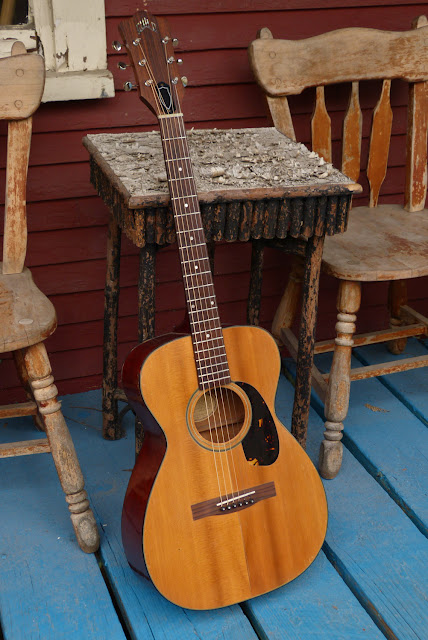1968 Guild F-20 0-size Guitar
Update 2017: A friend of mine brought this back in for consignment and I've gone through it and updated the post with new photos, a fresh soundclip, and updates in the text regarding new repairs.
This Hoboken, New Jersey-made Guild dates to 1968 from its serial number and is essentially a Guild version of the small-body Martin 0-18 models. It's roughly 0-size with a 14-fret neck and has a Gibson-flavored 24 3/4" scale as compared to some of these that had the longer 25+" scale later on in the model's history. The combination of a small body and 14-fret neck with x-bracing makes for a tone that's punchy, up-front, and midsy. It sounds superb as a fingerpicker and as a flatpicker makes recording very, very easy -- it remains defined.
Work included a fresh (2017) fret level/dress, light bridge shave, relocation of the saddle slot to where it should be, a new compensated bone saddle, bridge pin hole fill/redrill, and some cleaning and setup. This guitar had been repaired sloppily -- but effectively -- in the past: there are slipped seams on the front and back and various small hairline repairs & cleats to the front, but overall the work was "workmanly" and has held-up. I recall that I reglued bits of the binding here and there when I first worked on this in 2012, too.
The neck is straight, the frets have plenty of life left, there's some saddle height adjustment, a Fishman (as I recall?) passive undersaddle pickup installed, and action is dialed-in at 1/16" DGBE and 3/32" EA action at the 12th fret. The strings are 52w, 40w, 30w, 20w, 16, 12 gauges and they suit the instrument's mids-focus sound.
The neck is straight, the frets have plenty of life left, there's some saddle height adjustment, a Fishman (as I recall?) passive undersaddle pickup installed, and action is dialed-in at 1/16" DGBE and 3/32" EA action at the 12th fret. The strings are 52w, 40w, 30w, 20w, 16, 12 gauges and they suit the instrument's mids-focus sound.
I like the look of the small old-style pickguard on this instrument. The top is solid spruce while the back, sides, and neck are solid mahogany. The fretboard and bridge are rosewood.
When this came back in, I had to fill the saddle slot and cut a new on for proper compensation (the factory installed the bridge or saddle slot about 1/16" off. I then shaved it a bit, fine-sanded, buffed, and sealed it. It looks handsome.
There's an undersaddle pickup below the (new) bone saddle and the bridge has string ramps for better back-angle on the saddle, too. The pins are ebony with pearl dots.
There's an undersaddle pickup below the (new) bone saddle and the bridge has string ramps for better back-angle on the saddle, too. The pins are ebony with pearl dots.
When I got the guitar, the headstock appeared to have had its veneer sanded out to 200 grit. I polished it up and then rubbed in a few coats of satin finish to pop the rosewood out and seal it up. It's looking good.
This has a 1 5/8" nut width, a 14" radius, and a mild C-shaped neck profile. It's fast -- and stable.
As an aside -- why is it that so few makers use metal truss rod covers? They're so much more practical than those darn plastic ones that chip and break all the time.
The neck shape and feel of this is very much similar to an early '60s Gibson B-25 or somesuch.
This chunk of binding actually slightly overhangs the top edge and stubbornly refused to go back into place. There are a few areas of similar binding issues -- most notably on the back edge. It's simply not worth it in time to remove it all and re-rout the edge to reinstall it, though.
Here's another "slipped seam" area. It's totally not a structural issue, but it is a cosmetic one.
This has that typical Guild "red-stained" mahogany coloration to the hog back and sides.
The original tuners were replaced with these Kluson-style repro tuners at some point since I worked on it (by me). The originals on these were only so-so and these are far, far better. They have a few years of use, now, so they're looking more "correct" as well.






















Comments